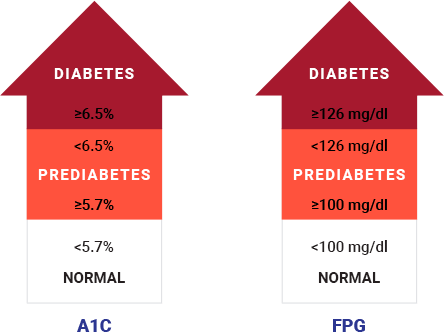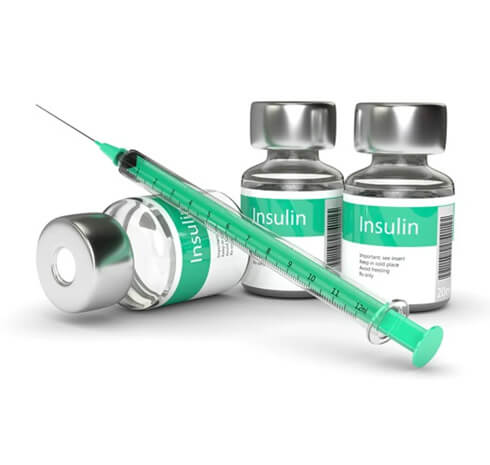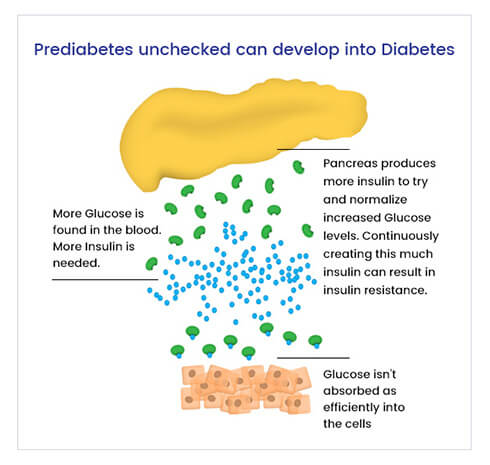
What is the difference between prediabetes and diabetes?
Have you ever heard the terms “borderline diabetes” or “full diabetes”? One term is saying you almost have diabetes whilst the other term is saying you do have diabetes. But what does that mean exactly? The difference between the two conditions is how high your blood sugar levels are.

Prediabetes is when your sugar levels are high but not high enough to be diagnosed as diabetes. The diagnosing criteria for prediabetes are having fasting blood sugar levels between 100-125mg/dl and having an A1C (a percentage of how much sugar coating is on your red blood cells) between 5.7% to 6.4%.
Prediabetes is interesting because it is mainly an “unofficial” diagnosis of diabetes and warning that you may get type 2 diabetes if you do not change your lifestyle.
Diabetes is classified as an A1C of 6.5% and fasting blood sugar levels at or above 126 mg/dL. There are two different types of diabetes: type 1 and type 2.

Type 1 is when the pancreas is producing little to no insulin (the hormone in charge of getting sugar molecules into the cells). It is usually diagnosed in children, adolescents, and young adults; however, it can develop at any age. It is thought to be caused by an autoimmune reaction (when the body attacks itself) but can be caused by genetics as well.
Type 1 diabetes is less common than type 2 and since there is no definite cause of this condition, it is less preventable than type 2. The only treatment for this condition is insulin.

In type 2 diabetes, cells do not normally respond to insulin therefore causing high amounts of sugar in the blood; this is called insulin resistance. Insulin resistance is usually more so caused by lifestyle habits such as having a diet rich in refined carbohydrates and sugars and primarily being sedentary.
Sometimes if any members of your family have diabetes, there is a chance that you might develop it as well. Furthermore, if you ever were diagnosed with diabetes while you were pregnant (gestational diabetes), there is a chance of developing the condition later in life.
Lastly, people who are black/African American, Hispanic or Latino, and Native Americans are more likely to develop type 2 diabetes. There are more of a variety of treatment options for people with type 2 diabetes than type 1, and more medications are being developed every day for this condition.

Insulin resistance exists in both prediabetes and diabetes. Usually, people do not even know they suffer from insulin resistance until they have developed the signs and symptoms of diabetes and have been diagnosed with the condition.
Most times, people will end up skipping over the prediabetes warning and end up diagnosed with type 2 diabetes. However, if you find out that you have prediabetes, there are ways to change the diagnosis.
Combatting prediabetes is as simple as changing your lifestyle. Reducing your intake of refined carbohydrates and sugars, eating more foods rich in protein, healthy fats and fiber, and becoming more active are great ways to boost insulin sensitivity and reduce blood sugar levels.

If you develop type 2 diabetes, although you may already have the condition and it cannot be reversed, there are ways to manage your blood sugar levels to avoid gaining complications in the future.
Test your sugar levels daily. This will allow you to see where your levels are and what adjustments need to be made to get them to your goal levels.
Limit foods in carbohydrates and sugar.
Become more physically active. The American Diabetes Association (ADA) suggests exercising at least 150 minutes per week, that is basically 30 minutes daily for 5 days a week!
Take any medications for diabetes as prescribed. Although you might be frightful and overwhelmed at having to take medicine for this condition, taking medicine as prescribed will help to control your sugar levels and will help to avoid serious complications caused by diabetes in the future.
It is crucial to know and understand your goal A1C and blood sugar levels. For people who have prediabetes, A1C goals are 5.6% or less and for those that have diabetes, their A1C should be less than 7%. The target range for fasting blood sugar level goals, should be between 80-130mg/dL for people with both diabetes and prediabetes.
The term “diabetes” whether there is a “pre-” in front or not, might seem like a scary diagnosis at first, but by changing your lifestyle you can prevent complications with your eyes, limbs, heart, and kidney, among other problems that are typically seen with people who have uncontrolled diabetes. Whether you have diabetes or prediabetes there is a way for you to still live a healthy life.
Still have questions? Call, or send us an email to learn more about how PreDia® can help.
*These Statements Have Not Been Evaluated By The Food & Drug Administration.This Product is Not Intended To Diagnose, Treat, Cure or Prevent Any Disease.